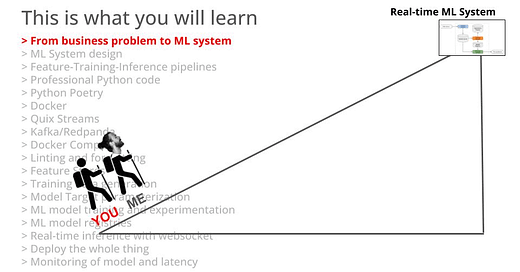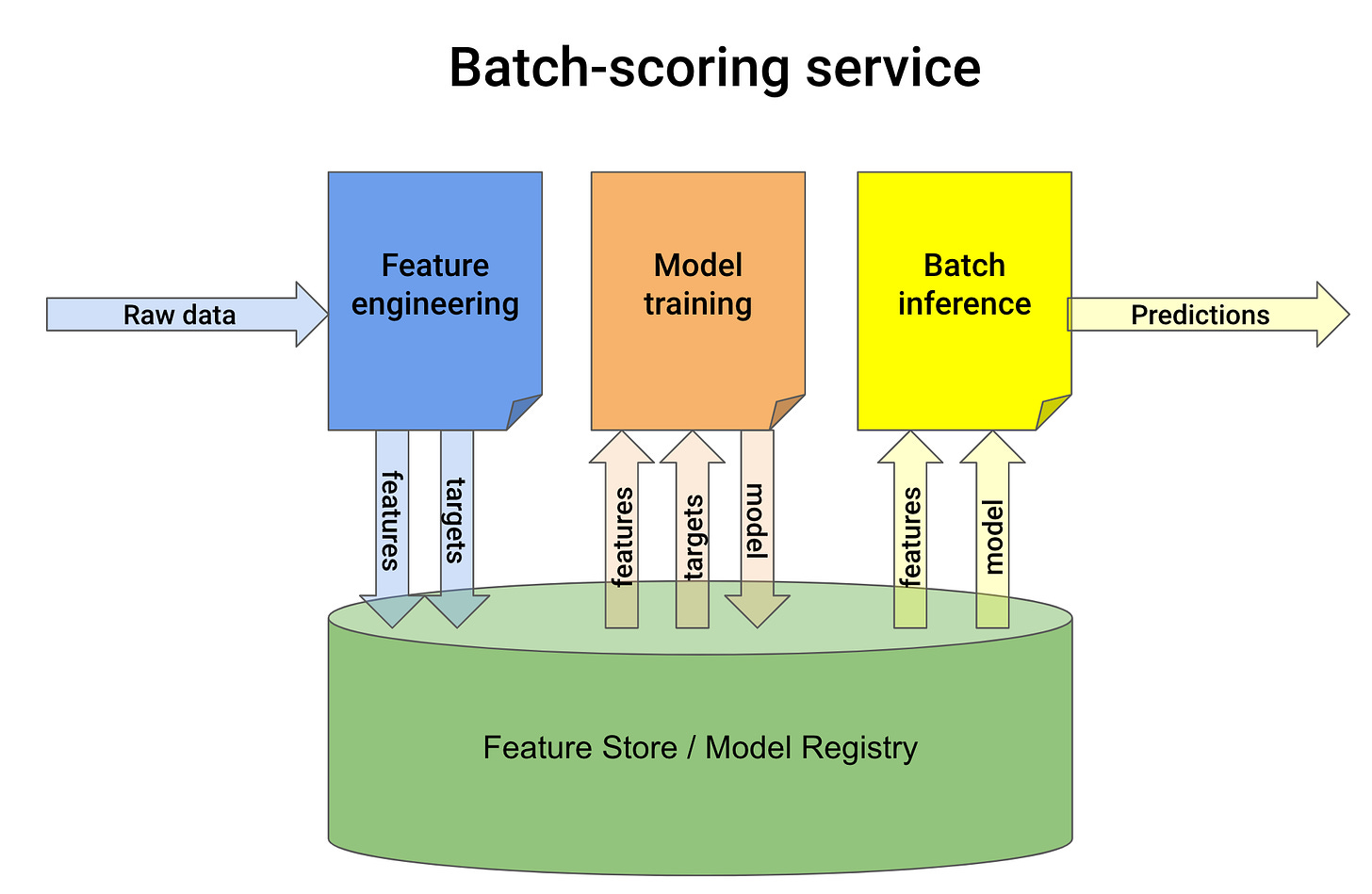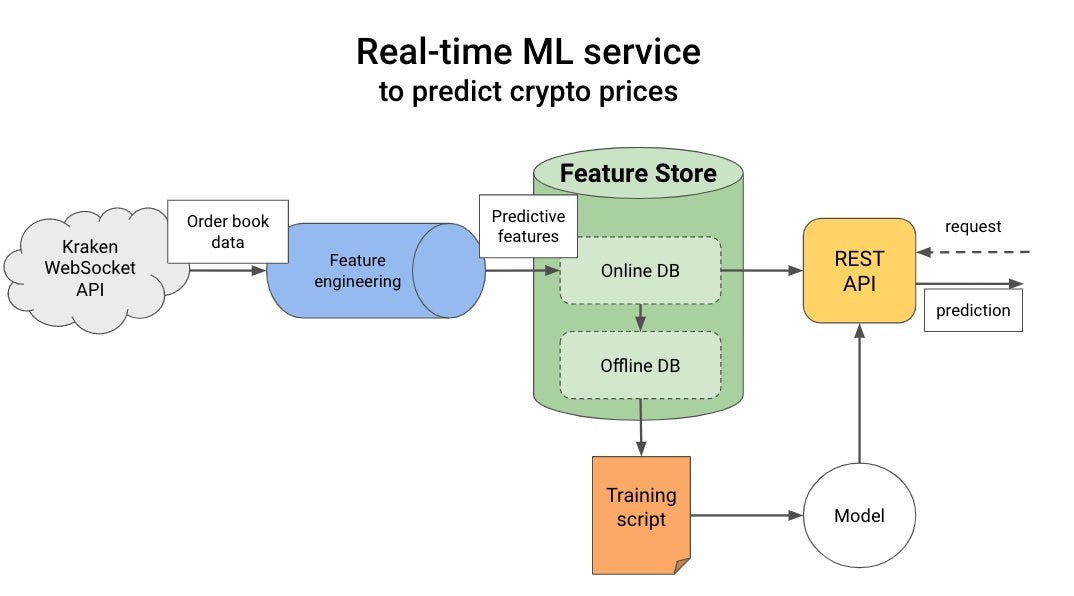Every ML system goal is to generate predictions, that are used either by:
human operators, or
downstream services
to make smarter decisions 🧠, that ultimately impact business metrics positively 📈.
The two most popular ML Systems
Depending on how often the ML system generates new predictions, we distinguish between 2 types of systems:
Batch scoring systems, that generate predictions at fixed intervals of time, for example hourly, daily or weekly.
Real-time systems, that generate predictions on-demand, either as a REST API, or a streaming app.
Let’s take a closer look at each one.
1. Batch scoring system 🕒
In a batch prediction your model is
→ fed with a batch of input features on a schedule (e.g. every 1 hour/day),
→ generates predictions for this batch, and
→ stores them in a database, from where developers and downstream services can use them whenever they need them.
Batch inference fits perfectly into Spark’s philosophy of large batch processing, and can be scheduled using tools like Apache Airflow.
Pros
✅ It is the most straightforward deployment strategy, and this is its main advantage.
Cons
❌ It can be terribly inefficient, as most predictions generated by a batch-scoring system are never used. For example:
If you work for an e-commerce site where only 5% of users log in every day, and you have a batch-scoring system that runs daily, 95% of the predictions will not be used.
❌ The system reacts slowly to data changes. For example
Imagine a movie recommender model that generates predictions every hour for each user. It will not take into account the most recent user activity from the last 10 minutes, and this can greatly impact the user experience.
Oftentimes, the slowness of the system is not just an inconvenience but a deal breaker. As an example, an ML-powered credit card fraud detection system CANNOT be deployed as a batch-scoring system, as this would lead to catastrophic consequences.
To make ML models react faster to the data, many companies and industries are transitioning their systems to online predictions.
2. Real-time ML system ⚡
The key difference between batch inference and real-time inference is the ability of your model to react to recent data. For that, you need to collect model inputs in real-time (or almost real-time, with a streaming tool like Apache Kafka) and pipe them into your model.
The model is deployed either
as a container behind a REST (or RPC) endpoint, using a library like Flask or FastAPI.
as a lambda function inside your Streaming.
Although real-time ML systems unlock new possibilities, they also come with high implementation and maintenance costs for most companies, as well as a lack of human expertise to keep them working.
Pros
✅ Your model takes into account (almost) real-time data, so its predictions are as fresh and relevant as they can be. Real-world examples are recommendation systems like TikTok’s Monolith or Netflix.
Cons
❌ Real-time ML has a steep learning curve. While Python is the lingua franca of ML, streaming tools like Apache Kafka and Apache Flink run on Java and Scala, which are still unknown to most data scientists and ML engineers.
Fortunately, things are changing fast in the last months, with the emergence of Python first tools like Bytewax, Quix or Pathway.
My advice 💡
If you haven’t built any ML system end-to-end, I recommend you start with a batch-scoring system.
This will help you build confidence, learn tons of things, and add your first real-world project to your ML portfolio.
Then you can go one step further and build a real-time ML system.
Wanna join the Real-Time ML expedition? 🥾⛰️
Next Monday 58 brave students and myself will start building a real-time ML system to predict short-term crypto prices. Step by step. In Python.
It will be a tough hike, but it will also be extremely fulfilling. Both for you and for me.
This hike will take us from
What you know now, which is mostly training ML models inside Jupyter notebooks using static CSV/Parquet files
to
What companies want, which is designing, building and deploying modular ML systems that impact business metrics 💰💰💰.
Do you want to join us in this amazing hike?
Early bird pricing ending tomorrow ⌛
Talk to you next week,
Let’s keep on learning
Pau






![[animate output image] [animate output image]](https://substackcdn.com/image/fetch/$s_!Advq!,w_1456,c_limit,f_auto,q_auto:good,fl_lossy/https%3A%2F%2Fsubstack-post-media.s3.amazonaws.com%2Fpublic%2Fimages%2F4753439a-59c4-41ab-bb1d-360bc1b2bcb9_960x540.gif)
Wow!